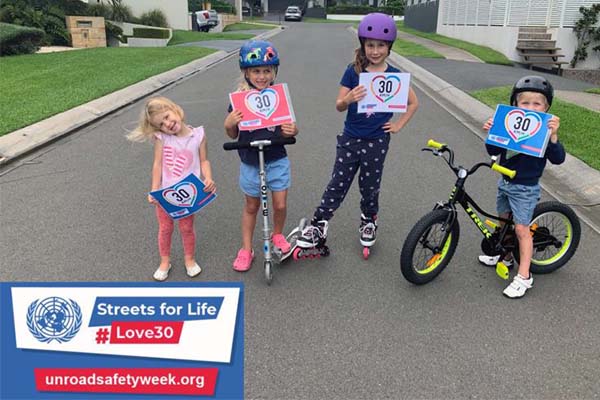Evidence is mounting in favour of lowering speed limits to 30 km/h in urban areas to make Aussie streets safer and happier places for children and adults to live and socialise.
Everyone benefits when they can take a walk or ride in their neighbourhood. We, also all benefit from healthier, less stressful and more active lifestyles with extra money back in our wallets.
“Our transport systems are the biggest threat to our lives within urban areas. There needs to be more emphasis on active forms of mobility to combat health problems, road safety concerns, congestion and to provide more vibrant liveable areas to grow and live.” Francis O’Neill, Head of Advocacy, Bicycle NSW.

Photo: Courtesy 30Please.org
More than a road safety issue, lower speed limits in urban areas also:
- Enable traffic to move more freely with minimal impacts on travel times
- Provide a reduction in air and noise pollution
- Provide a decrease in carbon emissions by increasing the number of people walking and cycling
- Enable younger people to move around independently and encourage parents to permit their children to do so
- Assist in combating rising levels of obesity by encouraging people of every age to walk and cycle and for children to play outdoors
- Transform our urban and village streets and residential areas from vehicle dominated through-roads into happy living ‘people-friendly’ spaces
- Bring Australia into line with the rest of Europe where 30km/h, (20 mph in the UK) is fast becoming the norm rather than the exception.
Towards Zero
Bicycle NSW has been supporting and will continue to support the 30Please initiative. The initiative shares the Office of Road Safety’s Vision of Zero deaths by 2050.
“Road crashes are a leading cause of death for children aged 1-14 in Australia. 30 km/h has been proven to work in theory and in practice. Let’s make it a priority to support school communities by creating safe streets within 2000m of every school and reducing speed limits to 30 km. ” Peter McLean, CEO Bicycle NSW.
There are many reasons why Bicycle NSW is doing this and why, alongside the UN and an alliance of organisations — led by ASPActivity & WeRideAustralia, we support such a scheme.
Our regional neighbourhoods lack footpaths and there is no funding planned to provide these in future. Austroads, has indicated that the most effective measure to date to increase pedestrian safety is the adoption of lower urban speed limits. We are seeing rising numbers of acceptance of lower speed limits across the world and a notable spread of area-wide and even city-wide 20 mph/30 km/h limits.
“In Australia, area-wide 30km/h limits in urban areas need to be developed and we need to accommodate for higher speed limits on arterial roads where infrastructure to protect cyclists and pedestrians is available. At speeds of below 30 km/h, cyclists and micro mobility devices can co-exist with motor vehicles in relative safety. “ Peter McLean, CEO Bicycle NSW.

Getty Images: Begin Residential area zone 30 kmh
30 Km Works
A study in Norway showed that a 10% decrease in the average speed of traffic is equal to a 37.8% decrease in the number of fatalities. The British Medical Journal found that the use of 20mph (32kph) over a twenty-year period from 1986 – 2006 significantly improved road safety for users of all transport devices and ages. Especially regarding children. The rate of children under 15 years old being killed and seriously injured dropped by 50% in areas where the speed limit is reduced to 20mph (32kph).
Graz was one of the first cities in Europe to enforce a city wide 30 kph zone. Approximately 800 km’s of a total 1000 km’s of city streets have been calmed. The outcome? After 6 months there was a 24% reduction in serious accidents. Graz also benefited from an increase in cycling and other active forms of transport.

Photo: Getty Images
Most Australians already support lowering speed limits in neighbourhoods. Acceptance usually increases after implementation, as has been the case in countries like the UK and Germany. Several 30km/h trials run in Melbourne and New Zealand before 2020 have been successful. Popularity increased further after people experienced the benefits.
Bicycle NSW is committed to making NSW a safer place to ride and walk. We advocate for the design, infrastructure, legislation and cultural shift needed to make our school journeys, commutes and social outings safer and more accessible for all. To become a Bicycle NSW Member join HERE.

